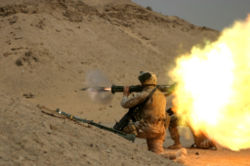Recoil
Recoil or kick (sometimes incorrectly called kickback[1]) is the tendency of a firearm to move backwards and at the same time the muzzle of the gun to rise when fired.[2] This is a reaction to the explosive force of a bullet leaving the barrel of a firearm.[3] A handgun shooter feels the recoil in the hands and arms. A rifle or shotgun shooter feels most of the recoil in his or her shoulder.[4]
Physics of recoil
Recoil is explained by Newton’s third law of motion.[5] It is usually paraphrased as: "to every action there is always an equal and opposite reaction".[6] In simpler terms, when a projectile and the hot gasses go forward, the firearm goes backwards.[5] There are a number of factors that determine the amount of backward force.
- Projectile mass - The bullet, shot or shell fired from any size gun has an effect on recoil. The heavier the projectile, the more the recoil.[5]
- Gun mass - The heavier the gun, the less the recoil.[5]
- Speed of the projectile - The faster the bullet, shot or shell, the more the recoil.[5] Also, the recoil will happen quicker than with a low mass projectile. This is felt as a "sharper' recoil by the shooter.[5]
For example, a .22 Long Rifle (the designation of the bullet not the gun) has very little recoil.[7] For this reason it is a caliber recommended for beginning shooters and, because the rounds are cheap, it is good practice ammunition for more experienced shooters.[7] It is a favorite ammunition for target shooting. By comparison, the .500 S&W Magnum handgun round has very heavy recoil.[7] Also, the recoil from the .500 magnum round is more sharply felt since the recoil speed is much greater.
Recoil anticipation
One of the first things new shooters want to know is if a gun will kick them.[8] New shooters learn to hold the gun firmly to reduce and control recoil. If firing a handgun, use both hands.[8] If firing a shotgun or rifle, press it firmly against the shoulder and press your cheek on the gunstock.[8] But, instructors often tell new students that recoil is 80% mental and only 20% physical.[9] In other words, no matter how well you hold the weapon, recoil anticipation can ruin every shot.
Recoil anticipation, or more commonly known as "flinching", is the unintended (not intended or planned mental and physical response to firing a gun. The shooter knows the loud noise and shock of firing the weapon is coming and at the last moment flinches. This often causes an inexperienced shooter to hit low of the intended target.[10] Another form of recoil anticipation is when new shooters unconsciously move the gun forward while pressing the trigger.[10] This is very difficult for instructors to see until the shooter presses the trigger on an empty chamber. Only then can the instructor see the shooter moving the gun forward.[10]
Another problem is jerking the trigger. Instead of smoothly pulling the trigger while concentrating on the target, an inexperienced shooter often "jerks" the trigger.[11] If shooters are consistently hitting low and to the left (right handed shooters) they are usually jerking the trigger.[11] Shooters probably don't understand that quickly yanking the trigger back ruins the shot.
All forms of recoil anticipation are eliminated or reduced through practice.[11] Good instruction in safe firearms practices is also very important.[12]
Recoil Media
Recoil while firing Smith & Wesson Model 500 revolver
Photograph of the kickback of a cannon, taken in Morges Castle, Switzerland
References
- ↑ Russ Chastain (1 December 2015). "Definition of Recoil". About Sports. About.com. Archived from the original on 31 May 2016. Retrieved 9 August 2016.
- ↑ Gun Digest 2015, ed. Jerry Lee (Iola, WI: Gun Digest Books, 2014), p. 239
- ↑ Wayne van Zwoll (21 March 2012). "The Science of Recoil". Gun Digest. F+W. Retrieved 9 August 2016.
- ↑ "Gun Recoil". The Physics of Everyday Stuff. Samuel Hokin. Archived from the original on 19 December 2012. Retrieved 9 August 2016.
- ↑ 5.0 5.1 5.2 5.3 5.4 5.5 Eric D. Puryear (28 April 2008). "Facts about Recoil, and Guns for People who are Sensitive to Recoil". LearnAboutGuns.com. Retrieved 9 August 2016.
- ↑ Morris L. Hallowell IV. "Illustrated Firearms Dictionary". Hallowell & Co., Inc. Retrieved 9 August 2016.
- ↑ 7.0 7.1 7.2 "Caliber Confusion". Stillwater Armory. Archived from the original on 3 August 2016. Retrieved 9 August 2016.
- ↑ 8.0 8.1 8.2 W.H. "Chip" Gross, Young Beginner's Guide to Shooting and Archery (Minneapolis, MN: Creative Publishing International, 2009), p. 60
- ↑ Ben Findley (22 March 2013). "Proper Grip: Guidelines & Techniques for Recoil Control". USA Carry. Retrieved 9 August 2016.
- ↑ 10.0 10.1 10.2 "Eliminating Anticipation of Recoil". Handgun Skills. 2016. Retrieved 9 August 2016.
- ↑ 11.0 11.1 11.2 Ben Findley (16 October 2015). "7 trigger control errors and how to fix them". Retrieved 9 August 2016.
- ↑ Robyn Sandoval; Barb Lucas. "Why Hiring a Firearms Instructor is Important". A Girl and A Gun Women's Shooting League, LLC. Retrieved 9 August 2016.
{{cite web}}: CS1 maint: multiple names: authors list (link)




